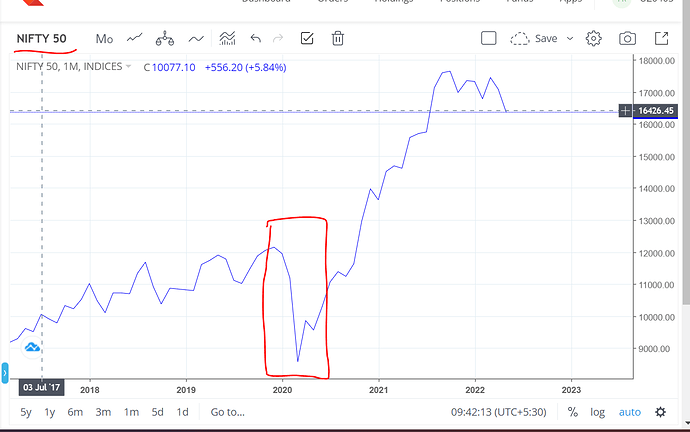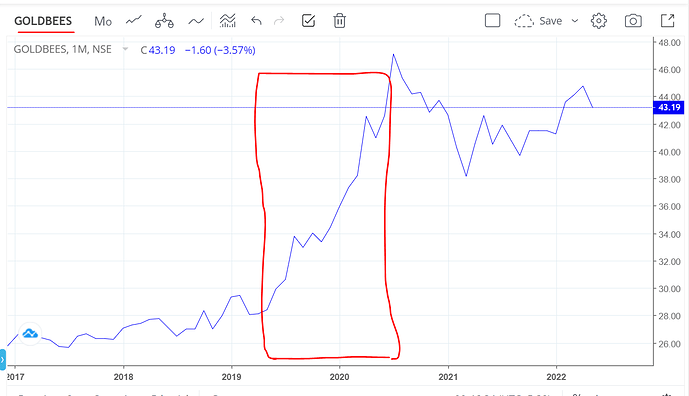Hello All,
I need your suggestion/guidance on my take regarding the portfolio that I hold in mutual fund.
Recently invested a lumpsum of 8,20,000 INR in 8 different mutual funds with a decent diversification and risk appetite where 2 funds have huge risk and 1 is small cap which is again risky and the other is contra, value fund, dynamic asset allocation, flexi cap, liquid and index funds.
I did a mistake of investing all my amount at once instead of doing it by tranches which would have been wise. I was aware of this but my psychology asked to go in a single shot, so I invested everything on 20th April when Nifty closed at 17136.
I could see now Nifty is at 16240 which is about 5.45% down from the high when I invested. My MF portfolio is down by 3.75% which is about 30600 INR in loss now. Can I safely assume that my MF PF is about 68% proportional to Nifty.
If this is correct, can I buy Nifty 29th Dec 18000 PE around 1710 premium now for hedging as I assume the market sentiment is negative. Is this considered as hedging or not.
I have a fair idea on the break even of this PUT and also time value decay and other related Greeks but not confident enough to decide on how to hedge this downfall as I don’t want to sell it now.
Your inputs and guidance can help me to plan and safeguard the principal I invested in MF. Awaiting your response and thank you in advance for your valuable input.
1 Like
First, it all depends on how much time you are willing to allocate to all this, bcos remember it is a headache.
2nd, you need to define your investment’s time horizon. If it Long-term(LT), then this short bumps are not to be worried about.
A perpetually hedged portfolio underperforms your typical holding portf.
3rd, if you want to still tread the path of trading this portf, you can look at covered call concept. Sell (short or write) some CEs, and leave it there.
4th You may tap into CE profits and fund buying PEs.
5th Point 3&4 will introduce additional accounting and ITR compliance. Even income from Equity and Derivatives will be treated differently. ( some more headache )
*headache: Means additional overhead that maybe mental, physical, educational or financial or all of them.
*PE: Buy far OTM if you do hedge
*CE: Write as close to comfort as possible, even weekly
*Repair strategy for CE going wrong is out of scope. Remember, this requires additional capital for margin and raises BP quite alot.
SIP is a good way for stress free deployment, otherwise if you are lucky and happen to get in post big correction is lucky. Time in market is more important than timing.
You did not mention your Equity exposure since you wrote liquid funds too but as a thumb rule consider NIFTY 1 FUTURES lot equivalent for CE.
PE can be aggressive buying in multi lots also if you are sure of short-term volatility and need not go too deep/far but all of this cannot be covered in a couple of lines. You buying and selling PEs will eventually turn into some form of trading instead of hedging.
Now you have to decide whether you want to take the Red pill or the Blue pill.
4 Likes
You need an edge to trade, loss aversion is no edge. trying to make back money is very dangerous mindset for trading. Hedging probably needs an edge to be justified else you will just have an expense in the long run. Most people lose money trading, it takes years to get the knowledge and skills needed and even then we always have some uncertainty.
3-4% is nothing. If you are going to hyper focus on pnl changes you will not be able to sustain. For short term investing ( say < 5Y) you need some kind of edge or luck. For retirement portfolios, this kind of movement means nothing - better to focus on your job and do regular investments. And diversify and have some non volatile assets for managing expenses and for diversification. Short term high quality debt is one option.
People capitulate at the worst possible prices and lose hard earned money. Imagine portfolio down at 20% - its unlikely from here but very much possible. Eventually market moves back up, but If you cannot handle drawdowns, then perhaps better to exit at 5% loss. SIP helps initially and its definitely better than lumpsum for managing emotions but eventually your portfolio will become much larger than SIP and then one day you will face this issue again - where you are fully invested and market is crashing. In these kind of markets you will always have bad news flow, there is always some reason for why its falling and there is fear and uncertainty.
Only fix is to look very very long term, manage your expectations - you will get some x% over inflation and also to diversify if possible. If you don’t invest, you will miss out on long term compounding and saving your savings from inflation.
4 Likes
Thanks for your detailed response, much appreciated. I am planning not to take any pill for now:)
Regarding equity, I have no exposure except for liquid bees and nifty bees for about 1.5 lacs
1 Like
It makes sense, thanks for your swift response. I will stay invested and will plan to have a long term perspective. Going forward, I need to control my mind to fine tune to market situations along with SIP investment at any market conditions.
1 Like
Since you asked this on a public platform I’m mentioning my thoughts without any bias or care for your sentiments.
-
Mutual Fund itself is a form of diversification and you are diversifying in mutual funds too. I advice you to stop this. From your style of mutual fund picking it seems that if you had 16 Lakh you would have invested in 16 mutual funds.
-
Nifty at 17K level is decent PE range and not at all an overvaluation. So according to me market will recover hence your principal in MF is safe.
-
If you want to hedge this is really a good option and you can proceed without giving a second thought.
-
My approach is little bit different. I would have done something different as I’m not a hedge fund manager for whom making return on investment every year is mandatory for saving his job. If you are optimistic about Indian Equities then put that money (you need 80K to buy 1 lot) in montly FD which you can break without hassle. When market falls further and starts recovery invest that 80K in mutual fund and you can make handsome profit when your initial investment in mutual fund is at breakeven level.
I totally agree with @SpacemanSpiff.
Investing in equity doesn’t comes without a noise. If you don’t want to see negative in PnL equity oriented funds is not for you.
1 Like
I totally agree with all the points GoutamHebbar, especially the first one:)
1 Like
Your mutual fund portfolio need not follow the same proportion in future rise/fall of Nifty. Past performance is not a predictor of future performance.
General rule is do not invest money in equity that you may need in next 3 years.
If you are risk averse, you can spend time learning about the hedging techniques, capital requirements, benefits and drawbacks of various approaches involved. It will be a valuable learning experience if you are interested.
If you buy DEC 18000 PE, it is considered a hedge for Nifty. Generally, most stocks tend to follow the direction of Nifty.
However, there is a possibility that some of your funds may not be closely following Nifty. In such a scenario, your hedge is not going to be useful.
You could consider withdrawing partially from your MF and wait for better prices if the invested amount is a large portion of your savings.
2 Likes
thanks Ragavendran for thoughtful insights
I believe you are looking for an hedge against your equity. Get 20% of gold in your portfolio. Set it and leave it for 4+ years. Goldbees ETF should do the trick
note:- Due to note down what’s in your MF. IF there is already gold get proportionately. I think your MF purely has equity & debt.
1 Like
Yes Rao, I shall think through it accordingly, thanks for your suggestion

